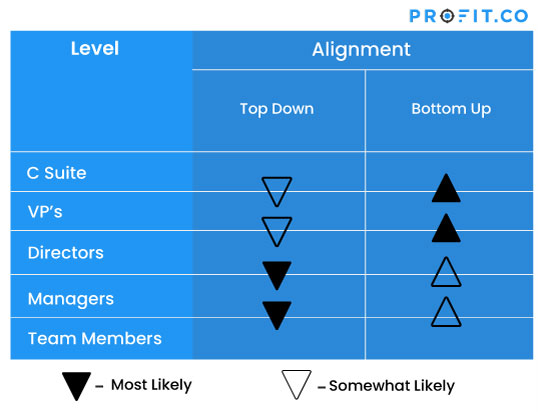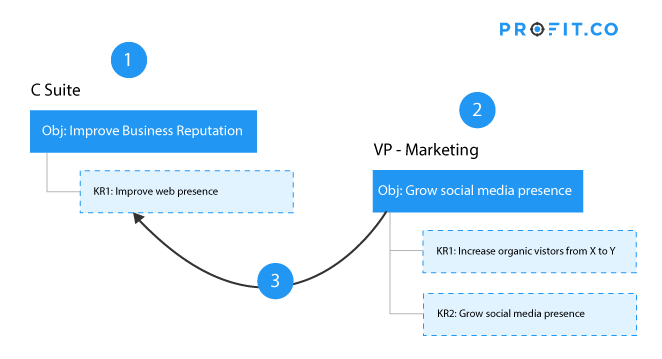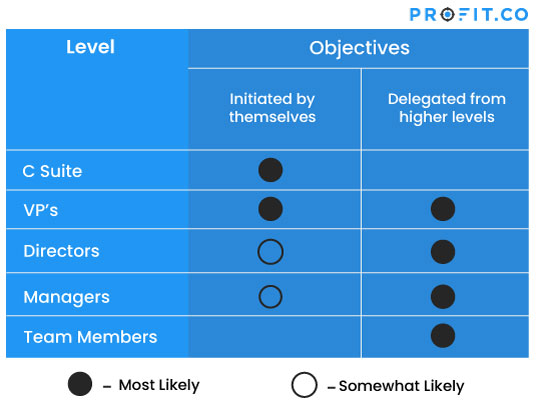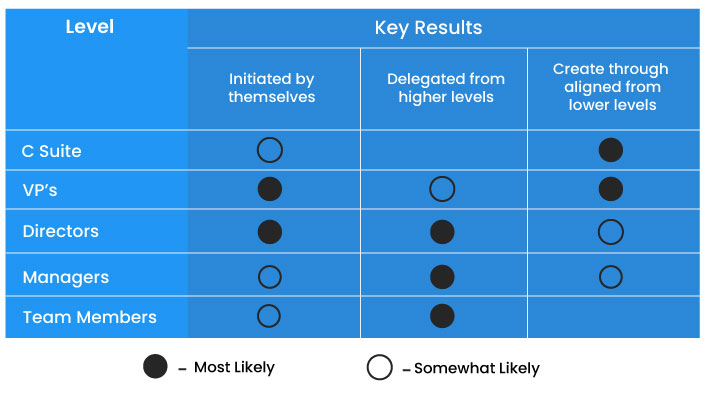Alignment is one of the key pillars of the OKR philosophy. Organizations achieve alignment both using a top-down approach and a bottom-up approach. We have seen organizations wanting to standardize on one approach, but it almost never works. It will make your OKR program very rigid, unnecessarily. You can certainly start with one and then add the other approach into the mix, as a practical alternative.
Consistent alignment of capabilities and internal processes with the customer value proposition is the core of any strategy execution.
So, let’s be clear at the outset — the extent of top-down and bottom-up alignment will be different at different levels of the organization. Middle management plays a key role in balancing these top-down and bottom-up alignments. A lot has been written about the importance of middle management or the sandwich layer. A study conducted by Wharton professor Ethan Mollick summarizes this well — “top management plays a significant role in setting the overall direction of the company. But they don’t have a big part in deciding which individual projects are selected and how they are run. It’s all about the middle managers.”
As a middle manager, you are in effect a chief executive of an organization yourself… As a micro CEO, You can improve performance and productivity, Whether or not the rest of the company follows suit.
Alignment
When it comes to alignment, this sandwich layer plays a key role in translating what the top management wants to the foot soldiers and getting the vision executed. So, as you can imagine, bottom-up alignments will be predominant in the upper layers of the organization, while top-down alignments will be predominant in the lower layers.
Let’s take a five-level example where you have the C Suite, Vice Presidents, Directors, Managers, and Team members. There may be Vice Presidents who report to multi-level directors and managers, but this is a simple representation.

Top management sets visions and corporate objectives, which, when achieved, help the company achieve its defined vision. However, in addition to setting these objectives, the C Suite relies heavily on the Vice Presidents to coordinate upward with the C Suite. This alignment happens in the form of Vice Presidents aligning up to the C Levels, as the key results of their Objectives.
In theory, this happens in 3 steps, at a granular level.

- C Suite establishes annual or quarterly objectives
- Vice Presidents understand the objectives and prepare what their objectives should be. And sometimes key results as well.
- VPs’ objectives are aligned up and made as the key results of the C Suite.
In practice, this happens collectively across many objectives of the C Suite and hence it’s a very complex process. But with practice, the quality of this exercise will be very revealing and set the tone for the quarter for the entire organization.
Objectives
When it comes to objectives, typically, the C Suite comes up with the objectives for the entire business and all the key functions.

Vice Presidents will come up with some objectives themselves, but also they get objectives delegated from the higher level. The mix of own versus delegated objectives for VPs depends on how their current departments/functions are linked and contribute to the overall business’s objectives:
- If a function is critical to the company’s objective, they tend to pick up their objectives from the company’s objectives.
- If a function is not critical to the company’s objective, they tend to develop their objectives that help other functions achieve the company’s objectives.
Whether or not a function is critical to a company’s objectives is not permanent, and a critical function in one quarter may not be critical in the next quarter. As we’ve heard, bottlenecks shift and managers need to be aware of this.
Directors & Managers are in a similar boat as Vice Presidents. There is a mix of own and delegated objectives. But the extent of the mix will vary depending on circumstances. And when it comes to individual contributors, objectives most certainly get delegated from above. There is very little chance of individual team members having their own objectives.
Key results
As we already discussed, the C Suite focuses on setting the long-term strategy and setting high-level objectives for shorter operating periods for the rest of the business to execute. For the most part, the key results for the objectives of the C Suite are generally created through bottom-up alignment from the next levels of management. And this is why if you look at the C Suite from the alignments perspective, it’s mostly bottom-up.

At the VPs’ level, they do have some key results that they are primarily accountable for, but quite a bit of their key results still get created through bottom-up alignment from the director’s level below them.
Directors & managers are very similar, but the extent of key results created by themselves Vs. delegated from above Vs. aligned from below will vary. This is what makes the middle management layer very challenging. A disciplined OKR program can make these challenges less daunting and make the job of middle managers easier to a certain extent. The visibility, transparency, and alignment aspects of the OKR methodology help middle management the most to get the business moving in the right direction at a much faster pace.
Regarding individual contributors, key results are sometimes certainly initiated by themselves, but mostly delegated from higher above. And hence the alignment is mostly top-down and not really bottom-up.
Summary
Middle management plays an important role in communicating top-level visions to the teams that carry them out. This sandwich layer intelligently bridges the top-down and bottom-up arrangements and serves to clearly convey the vision to everyone important. Schedule a demo with an OKR expert to learn more about how OKR, managed by Profit.co, can help you improve communication and engage with your employees.


